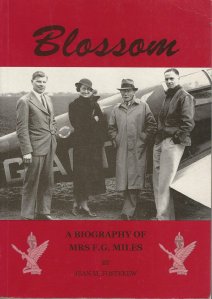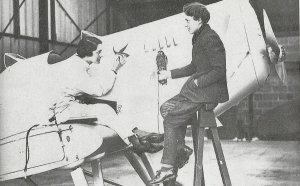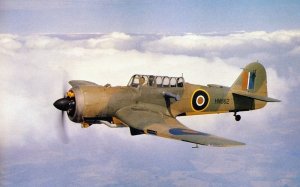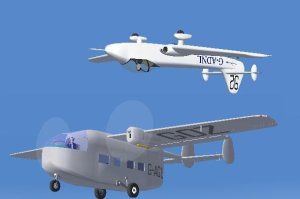Simanaitis Says
On cars, old, new and future; science & technology; vintage airplanes, computer flight simulation of them; Sherlockiana; our English language; travel; and other stuff
MILES AIRCRAFT LTD AND ITS M.57 AEROVAN
THE BRITISH Miles Aircraft Ltd was a family business, and what a family it was: See http://wp.me/p2ETap-24M.

Blossom: A Biography of Mrs F.G. Miles, by Jean M. Fosterkew, Cirrus Associates, 1998. On the left, F.G. and Blossom Miles; on the right, Hugh Brooks and Charles Powls, Poole & Powls business associates.
The varied talents of F.G. Miles, his wife Blossom and his brother George produced civil and military craft, from the 1932 M.1 Satyr through the 1957 M.105 (also known as the HDM.105, as in Hurel-Dubois Miles, of which more anon).
Their 1932 M.1 Satyr was a one-off, but 55 examples of the M.2 Hawk left the company’s Woodley, Berkshire, works in 1933, followed by 64 M.2F-T Hawk Majors in 1934.

Blossom paints a Hawk image on the fuselage of a Miles M.2 Hawk. Her sister, actress Jean Forbes-Robertson, holds the real model. Image from Blossom.
Miles Aircraft introduced its M.14 Magister basic military trainer in 1937; eventually 1293 of these were produced.
The M.25 Martinet target tug’s production ran to 1724 aircraft (Miles’ most numerous design) during World War II.

Miles M.25 Martinet TT MkI target tug. The fuselage fitting could hold a horizontally mounted four-blade prop powering the tow hardware.
My favorite Miles, the M.57 Aerovan, appeared almost at the end of WWII. The Aerovan had a boxy fuselage capable of carrying 10 passengers or, through its swinging rear hatch, accommodating an automobile.

My Miles M.57 Aerovan 1, modeled for Microsoft Flight Simulator, carries a Cooper Formula 3 car in Rob Walker livery.
The M.57 was constructed of plastic-bonded plywood with some spruce and metal components. Power came from twin 148-hp Blackburn Cirrus Major inline-4s inverted in high-wing nacelles.
Aerovans were used as light commercial transports in more than a dozen countries; they served as well in the air forces of Israel and New Zealand. One fitment offered was an emergency operating theater, the idea being to bring the doctor and nurse to the patient rather than vice versa. See the aircraft’s writeup in Flight magazine, June 7, 1945 (http://goo.gl/8KHSxI).

Don’t try this at home, kids; we’re professionals. My M.57 is having fun with Edward Cook’s Miles M.77 Sparrrowjet, an F.G. one-off.
F.G. got the firm involved in more than aircraft design. One of its secret wartime activities involved ball-point pens. (Aircrews found ball-points better than fountain pens at altitude; mariners preferred them in wet weather.)

László József Biró, 1899 – 1985, inventor of the ball-point pen, or biro as it’s known in many countries.
The concept’s inventor, Hungarian László József Biró, licensed F.G. Miles to aid in the pen’s development. Students at the Miles Aeronautical School were given these pens for trial use. Frenchman Marcel Bich bought the patent from Biró in 1945; he co-founded Bic.
The Photographic Department of Miles Aircraft also developed the Copycat, a photostatic copying machine. F.G. much preferred the device in lieu of carbon paper. However, in 1946 the American company Haloid beat the rest of the world in commercializing the photocopier. (It became Haloid Xerox in 1958 and Xerox in 1961.)
Caught up in Britain’s post-war economic doldrums, Miles Aircraft Ltd went into receivership in 1947. However, F.G. didn’t go quietly. A new firm, F.G. Miles Ltd, spun off a group of subsidiary companies, among them Meridian Airmaps Ltd, Miles Marine & Structural Plastics Ltd, Jet Tanks Ltd and Miles Electronics Ltd, this last one manufacturing flight simulators and eventually merging with the British arm of the Link Trainer company.

HDM.105, an M.57 fitted with a Hurel ultra-high-aspect-ratio wing. Image from Flight magazine, April 19, 1957.
In a concluding bit of Aerovan lore, one of the M.57s was converted into the HDM.105, a joint venture between Miles and the French company Societe des Avions Hurel-Dubois. The latter company exploited Maurice Hurel’s wing designs of extremely high aspect ratio; that is, chord being dramatically small for a given wing span.
In 1958, Miles sold the design to the Shorts Bros, another British aircraft manufacturer, which developed it into its own SC.7 Skyvan.
Imitation, they say, is the most sincere form of flattery. ds
© Dennis Simanaitis, SimanaitisSays.com, 2014



Miles was such an incredibly creative company!
Encyclopedia books on Miles Aircraft have been now published by Air-Britain. There are also two books out now on the Miles M.52, which would most likely have beaten the Bell X-1 in going supersonic. A great, but sad, story…
Miles Aircraft Ltd did NOT go bankrupt – they went into Receivership – long and miserable story. For details see the third volues of my book – Miles Aircraft – The Post War Years.
Peter Amos
Miles Aircraft Historian
Thanks for this distinction between receivership and bankruptcy. As you see above, a few deleted words likely brings matters right.
By the way, the Miles M.57 is one of my favorite aircraft.